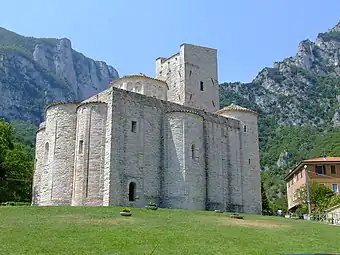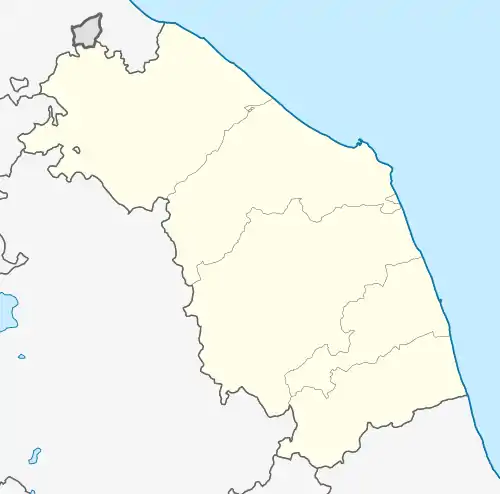Genga, Marche
Genga is a town and comune of province of Ancona in the Italian region of the Marche, on the Sentino river about 7 kilometres (4 mi) downstream and east of Sassoferrato and 12 kilometres (7 mi) north of Fabriano.
Genga | |
|---|---|
| Comune di Genga | |
 San Vittore Abbey. | |
Location of Genga | |
 Genga Location of Genga in Italy  Genga Genga (Marche) | |
| Coordinates: 43°26′N 12°56′E | |
| Country | Italy |
| Region | Marche |
| Province | Ancona (AN) |
| Frazioni | Avenale, Bivio Filipponi, Camponocecchio, Capolavilla, Casamontanara, Cerqueto, Colcello, Colleponi, Falcioni, Gattuccio, Meleto, Monticelli, Palombare, Pianello, Pierosara, Rocchetta, Rosenga, San Donnino, San Fortunato, San Vittore, Trapozzo, Trinquelli, Vallemania, Valtreara |
| Government | |
| • Mayor | Raniero Nepi |
| Area | |
| • Total | 72 km2 (28 sq mi) |
| Elevation | 320 m (1,050 ft) |
| Population (2008)[2] | |
| • Total | 1,984 |
| • Density | 28/km2 (71/sq mi) |
| Demonym | Gengarini |
| Time zone | UTC+1 (CET) |
| • Summer (DST) | UTC+2 (CEST) |
| Postal code | 60040 |
| Dialing code | 0732 |
| Patron saint | St. Clemens |
| Saint day | November 23 |
| Website | Official website |
The town is best known as the ancestral home of the noble family of the della Genga, the most famous member of which was Pope Leo XII.
Main sights
- Grotte di Frasassi, they are a karst caves system most famous show caves in Italy.
- the Romanesque abbey at S. Vittore alle Chiuse (11th century).
- the Roman Bridge in the same hamlet, about 8 kilometres (5 mi) southeast of town.
- Museum of the church of San Clemente. It houses a triptych and a 15th-century banner by Antonio da Fabriano.
- Spaelaeo-Palaeontologic Museum, including a famous fossil of an Ichthyosaur known as Gengasaurus found in the area in 1976.
The Frasassi Caves, about 5 kilometres (3 mi) south-southeast, are among the most visited natural curiosities in central Italy.
References
- "Superficie di Comuni Province e Regioni italiane al 9 ottobre 2011". Italian National Institute of Statistics. Retrieved 16 March 2019.
- "Popolazione Residente al 1° Gennaio 2018". Italian National Institute of Statistics. Retrieved 16 March 2019.
This article is issued from Wikipedia. The text is licensed under Creative Commons - Attribution - Sharealike. Additional terms may apply for the media files.